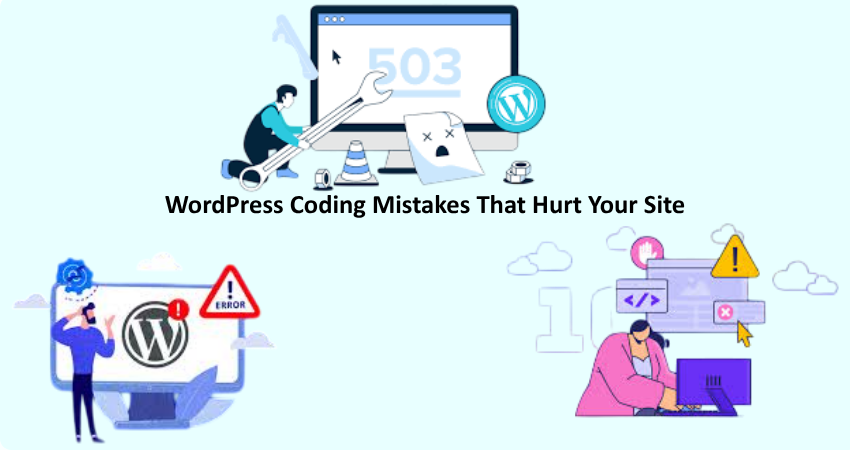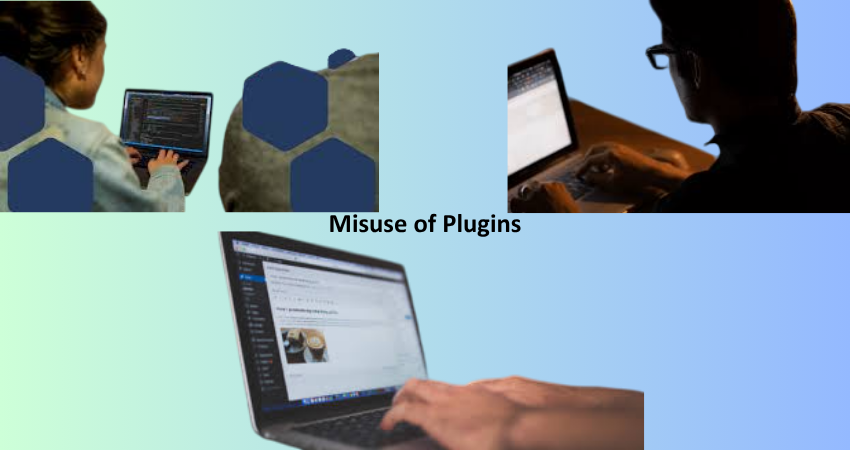
Introduction
WordPress is the world’s largest content management system, powering more than 40% of the websites in the internet. It is flexible, easy to use, and has a vast library of plugins, making it an excellent choice for beginners and experienced developers alike. But great power comes with great responsibility. Coding mistakes-from novice developers or even site owners fussing around without understanding best practices quite well-can severely affect the performance, security, and user experience of their websites.
This article will also take the reader through the most frequent WordPress coding mistakes that can jeopardize your website. Each section will delve into a particular mistake, its dangerous potential, and tips on how to avoid or repair it. If you are a developer or a site owner looking to understand better the foundation of your site, such mistakes would help you build a better, more reliable WordPress site.
Poor Theme Development Practices
Ignoring WordPress Coding Standards
Most developers ignore WordPress’s official coding standards in developing custom themes, but let us tell you that they exist for some reasons: Code Consistency, Security, and Compatibility, which otherwise might lead to such code that could be either difficult to maintain, insecure, or incompatible with future updates of WordPress.
Some of them- incorrect opening or closing of PHP tag, values hardcoded, or sanitized or validated user inputs have importance when it comes to security risks. A theme can launch on a note-but due to poor coding practices, even a minor WordPress update will break part of your site. Worse, it may hinder collaboration because other developers will not have it easy to understand or modify your code.
Now by abiding by coding standards of WordPress, you not only make your codes cleaner and more efficient but help outweigh the inevitability that your site will be stable and secure even as it grows. PHPCS (PHP CodeSniffer) with WordPress coding standards can easily automate a part of it such that it won’t be tedious to spot and correct errors in theme files that otherwise might grow into major issues.
Not Using Child Themes
Editing a parent theme directly, rather than making a child theme, is another major mistake. Sure, making edits to the main theme files that you need for design or functionality is nifty, but this decision proves terribly short sighted. Parent theme update means you lose all your custom handiwork, and your functionality could break.
A much wiser route would be to create a child theme. The child theme acts as an extension or modification to a parent theme, which keeps the parent theme core files intact. This means that when the parent theme is updated (for instance, to take advantage of new features or security patches), all your modifications are still there and working. The WordPress Codex has exhaustive documentation on creating a child theme because it is a very simple process.
Not using child themes is not only a maintenance nightmare but also a scaling and updating confidence-killer. Whether as a freelancer or an agency handling the multiple client sites, child themes should always be part of your workflow.
Misuse of Plugins

Installing Too Many Plugins
The greatest strength of WordPress (actually its very large library of plugins) becomes one of the major weaknesses in no time. Very often, new users fall into the trap of installing additional plugins, with an aim to add some functionality to their site. But, the more plugins you set up, the greater the potential of code clash, a loss in performance, and vulnerability in security.
Some plugins have been poorly coded while others are not compatible with your theme and other plugins. As a result, this creates an unstable ecosystem such that a minor update can cause a major issue. Not to mention the HTTP requests, database queries, and background processes added by each plugin that slow down the website.
This is where you need to learn moderation and discernment: only install those most widely used, constantly maintained plugins that deliver required functionality for your site. Now it’s up to you to regularly audit your plugin list and remove the ones you don’t really need or have become defunct. Tools like Query Monitor can help you scout out which plugins are really hogging resources.
Failing to Keep Plugins Updated
Another big blunder that you can make is that even though you’ve maintained a tight list of all quality plugins, you forget to update them. Updates are issued by developers to plug security loopholes, fix bugs, and improve performance with whatever means they can. Failing to update these plugins simply exposes your site to danger.
Outdated plugins are among the top attackers’ tools of preference. They will keep scanning and crawling the Web for vulnerabilities existent in older versions of any plugin. When they find an outdated plugin on your site, that plugin can easily be exploited to upload malware, deface the site, or steal user data. Keeping up with new plugin updates is an easy but powerful way of securing your website.
Using plugins such as Wordfence or iThemes Security can help you monitor plugin activity and get notifications whenever an update is available for your plugins. If multiple WordPress sites are being managed, consider using a centralized dashboard such as ManageWP for convenient plugin update management across all projects.
Inefficient Database Management
Not Optimizing Database Queries
Badly written database queries get into very severe speed degrading at its best performance. Many times, developers write and still run those unoptimized queries when large amounts of data are fetched, or massive joins are done without indexing. Such mistakes lead to slowing down pages, and particularly so in the case of content-heavy and popular websites.
For instance, there might be an offense of SELECT * without thinking about whether it only needed a handful of columns. Or one may trigger one of those gigantic maximum-row scenarios that put unwarranted strain onto the pool, database, and server with their cacophony. Over time, this culminates in sluggy performance for the website and increased hosting costs.
The solution simply lies in writing efficient SQL queries and making use of built-in methods like WP_QUERY, which from WordPress point of view matches performance and security. Plugins like Query Monitor and New Relic also come useful in identifying slow queries ostensibly starting with a clear point for optimization.
Neglecting Database Cleanup
With time, enormous surplus data gets accumulated within the WordPress database, that is, revisions, posts in the trash, spam comments, transient options, and tables from plugins that are no longer in use. If not cleaned regularly, this bulky presence can slow down your site and take up unnecessary space during backups.
Database optimization lies in the routine maintenance. Cleaning can be accomplished through the use of plugins like WP-Optimize or Advanced Database Cleaner. In either case, always back up your database before performing any intensive cleaning.
Other than deleting unwanted data, you may also want to OPTIMIZE the tables in your database using the command OPTIMIZE TABLE in phpMyAdmin. This helps redo the performance on your data storage and thus gives a speeding edge on their access. Plan scheduled clean-up and optimization so that your WordPress site runs in utmost smoothness and efficiency.
Security Oversights
Leaving Debug Mode Enabled on Live Sites
Debug Mode in WordPress is the most powerful tool that you can have during development; it catches errors and notices that would otherwise go unnoticed. Keeping it running on a live site, however, is a gross security oversight. It could expose physical paths, database credentials, and plugin configurations.
Hackers can utilize such information to locate vulnerabilities in your configuration. This not only damages your image but also proves that your site is very unprofessional and untrustworthy. Use the wp-config.php file and ensure that WP_DEBUG is set to false before you go live.
If you must monitor issues on a live website, do so cautiously with logging tools like WP_DEBUG_LOG. Never forget to direct these logs to a secure area, far from public reach. A clean error-free interface promotes professionalism and protects your backend from curious eyes.
Using Insecure Login Credentials
Surprisingly, many site owners still use passwords like “admin” or “password123,” which make brute-force attacking trivial. It is an endless job for these automated bots that use WordPress sites for trial and error, trying thousands of username/password combinations.
Strong and unique passwords as well as changing the default “admin” username greatly improve the security of your site. Implement two-factor authentication (2FA) by using plugins like Google Authenticator or WP 2FA to add another layer of security.
In addition to that, limit some attempts and also apply CAPTCHA to avoid automated intrusion. Keeping your login password is one step that is simple but promises high dividends in the security of your site from unauthorized access.
Performance Bottlenecks

Not Implementing Caching
Probably one of the most popular causes of slow WordPress sites is lack of caching. Caching creates static versions of your content so there is less dynamic PHP execution and less database queries to serve a page.
Every page request without caching demands that your server perform all kinds of backend logic, which slows things down quite a bit, especially under heavy traffic. Page, object, and browser caching is a feature present in these plugins: W3 Total Cache, WP Super Cache, and LiteSpeed Cache, which can do wonders when it comes to loading time improvement.
Server-side caching, if available from your hosting provider, tends to work even better. When you combine caching and CDN, your site can deliver a lighter experience for users—a bonus for both usability and ranking high on result pages.
Using Uncompressed Images
Images can be the heaviest elements in a webpage. The uploading of big, unoptimized pictures is a common mistake that can greatly add to loading time. This phenomenon leaves users frustrated and has a bad effect on SEO, for Google considers site speed an important ranking factor.
It is a rule of thumb to always resize and compress an image before upload. TinyPNG, ShortPixel, or Smush are some of the tools that you can use to compress images without destroying the quality. Also, serving in next-gen formats like WebP would further reduce the file size.
Use lazy loading to postpone loading images that are offscreen until they are needed. This will improve initial page load time and enhance your site’s perceived speed: image optimization is one of the simplest and most effective ways to enhance site performance.
Conclusion
In terms of coding, performance, and security, one can thoughtfully consider managing and running their WordPress site, not just about putting up some themes and plugins for it. By acknowledging and avoiding the most common coding mistakes from this article-poor theme construction all the way up to inefficient database setups and security that might have been left unchecked-you place yourself in a much better position to build an actual site that will be fast, secure, and scalable.
Alone, each of these mistakes may seem insignificant, but when looked at together, they may severely cripple your site’s efficiency and integrity. Learn the best practices, routinely audit the code you write, and keep going with the very rapid place that is brought by word press environment. Your users-and your business-will thank you for it.